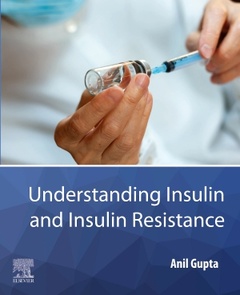Understanding Insulin and Insulin Resistance
Auteur : Gupta Anil

2. Structure and properties of insulin
3. Biosynthesis of insulin
4. Biosynthesis, intracellular-trafficking, and exocytosis of insulin granules
5. Regulation of insulin secretion
6. Regulation of insulin secretion
7. Direct and indirect actions of insulin: role of insulin receptor, glucose transporters (GLUTs), and sodium-glucose linked transporters (SGLTs)
8. Metabolic and physiological effects of insulin
9. Etiopathogenesis of insulin resistance
10. Insulin resistance syndrome
- Provides exhaustive and latest knowledge related to the chronology of diabetes mellitus, different phases in the discovery of insulin, contribution of several workers in discovery of insulin, insulin structure, types of insulin, and role of latest insulin delivery devices including various transdermal insulin delivery devices and bionic pancreas in the management of diabetes mellitus
- Delivers extensive and current information relevant to structure of insulin gene, role of insulin gene-variable number of tandem repeats, insulin two genes versus single gene system, role of wide array of promoters, transcription factors, hormones and nutrients in the regulation of transcription of insulin gene speckled with description of dysregulation of insulin gene transcription by glucotoxicity, lipotoxicity, unfolded-protein response, and activating transcription factor-6
- Provides knowledge about biogenesis of insulin granules, role of SNARE proteins, SYNTAXIN, SNAP-25 and VAMP-2 in the intracellular trafficking and exocytosis of insulin granules
- Important component of book is the description about models of capillary blood flow in pancreatic islets, triggering pathway, amplifying pathway, role of nutrients, hormones especially Malonyl-CoA/Long chain-Acyl-CoA pathway, glucagon-like peptide-1, cholecystokinin hormone, ghrelin hormone, insulinotropic and insulinostatic effects of noradrenaline, Sirtuin 1, and mechanistic target of Rapamycin (mTOR) in insulin secretion
- Book proves knowledge about insulin mediated signaling pathways, role of glucose transporters, sodium–glucose linked transporters, and coverage of several metabolic and physiological effects of insulin including insulin mediated RANKL/RANK/OPG axis in osteoclastogenesis and bone resorption
- Additional component of the book is the chapter on the etiopathogenesis of insulin resistance covering wide range of topics including role of genetic polymorphisms (gene FABP-1, gene
Date de parution : 11-2021
Ouvrage de 320 p.
19x23.4 cm
Thème d’Understanding Insulin and Insulin Resistance :
Mots-clés :
Insulin resistance syndrome; obesity; diabetes; inflammation; cellular stress; mitochondrial dysfunction; metabolic syndrome; polypeptide chains; disulfide bonds; glucose; amino acids; secretion of insulin; fatty acids; hormones; ?Aggregation; Alpha; And delta cells; Atherogenic dyslipidemia; Beta; Biosynthesis; Blood flow; Diabetes mellitus; Endocrine; Gastric inhibitory peptide; Glucose homeostasis; Hyperinsulinemia; Hypertension; Hypothesis; IL-6; INS gene; Impaired glucose tolerance; Insulin; Insulin dimer; Insulin glargine; Insulin granule; Insulin monomer; Insulin resistance; Insulin resistance syndrome; Insulin secretion; Islets of Langerhans; Long-acting insulin; Low-calorie diet; Neurons; Obesity; Pancreas; Pancreatic islets; Polycystic ovarian syndrome; Polypeptide; Proteolysis; Rapamycin; Short-acting insulin; Sorting receptor; TNF-alpha; Tandem repeats; Transcription



